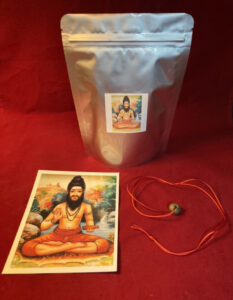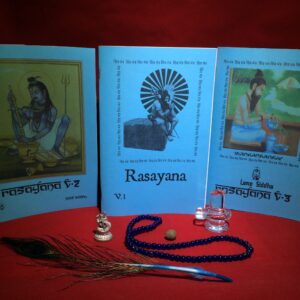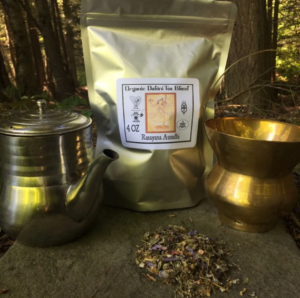The copper Havan Kund is one of the most important part for ritual, with its conductive metal being the celestial conduit from the earth to the heavens. Fire is the spiritual vehicle for communication and sacrifices of sweet herbs and plants to the enlightened and holy intelligences that are in the subtle realms. These are the stars, the siddhas that work for the benefit of humanity in their stellar inspiriations linking their energies to those that raise their energy and vibrations enough to be noticed. This is the glance of the gods the Grace Light that descends from above when the soul is lifted with all devotion, knowledge, effort and action one can muster. It’s a very sacred structure from where the fire communicates all our prayers to different deities. The structure itself generates energy to perform the ritual. The sacred fire acts as a link between man’s consciousness and the cosmic consciousness. It is the pyramid or the pyre or fire, amid which is inverted bringing the celestial down into the conducting copper. We give you this size which is personal for the ritual and packable for our suggested retreats and fire rituals in far off wild places (please be careful of wild fires) and a very special place to do fire rituals is on a stone in a water area or on the banks of waters and putting some sacred ashes into alchemical purifications of your area. Your ashes are your sacred medicine, we provide the 108 Ritual Soma Fire Homa Havan Agnihotra Puja Herbs in small packet which only needs a tiny pinch to get the essence, power and blessings. Therefore this goes a long way. But we encourage one to find the sacred medicinal plants of one’s own region and add them into the mix and even be the bulk of the fuel. Because there are local deities that we do not see, plant spirits unique to our area that can be honored and attuned with and presenced in linking and fusing them into the ancient fire rituals that were universal rites of all sacred peoples. This can be the wild herbs and flowers of one’s home and forest, the medicinal offerings of the garden and harvest. This is crucial to manifest the sacred into one’s life and contextualize it in their integrated experience and not just mimicking practices in Asia. Everywhere the fire rituals went they adapted and added in local customs, ingredients and spirits and deities, festivals and intentions. True spiritual power comes from infusing one’s actions with intention and energy enough to effect change and power. This can be a healing or spiritual power or a protective to cursing power. But one must be infused with the ritual and let the ritual be infused by them.
The Vedas, the most ancient wisdom revealed to man, have recommended Agnihotra, so that man can build up a fundamental attitude towards his life from body, mind and soul angle. Innumerable persons, by performing Agnihotra regularly, have experienced this basic change in their way of thinking, towards ever mounting problems of life. With the researches on Agnihotra a new horizon has been re-opened, for the IT generation of the world. The Agnihotra is the ‘Nitya’ Yajða. Nitya denotes its regular nature. As per the Vedas, it is to be performed every evening and every morning, ie. exactly at local sunset time and exactly at local sunrise time. ‘Agni’ means fire and ‘hotra’ means offering oblation. Thus Agnihotra is the act of offering oblations to Agni – fire. It is not a mere ritual. But is a part and parcel of Vedic science. This Yajoa is to be performed regularly throughout the life. Yajða is the technical term from the Vedic science of bioenergy denoting the process of removing the toxic conditions of atmosphere through the agency of fire. This meaning purifying of the atmosphere with fire as the medium. When one heals the atmosphere, the healed atmosphere heals him. As any other Yajða, Agnihotra is performed in a special manner. Certain disciplines have to be followed while performing Agnihotra. With a little practice everyone can perform it. It does not take more than five to ten minutes to perform.
Procedure:
Agnihotra is performed twice a day. A semi pyramid shaped copper pot is prescribed for Agnihotra. The pot – copper pyramid should be placed on a fire-resistant place. When the fire is ignited in the pot, it gets quite hot. A small fire is prepared with the dry cow-dung cakes in the pot. The cow-dung pieces should be arranged so that there is good ventilation in the pot. First put a small piece below and then arrange the pieces- one above the other to let have some gap in between them. One can use gugul, camphor or cotton wick soaked in cow ghee to ignite the fire. Use of any petroleum products should be strictly avoided. For oblations raw rice is required. Thirty to thirty -five grains per oblation are sufficient. It is almost two pinches of raw, unbroken rice grains, smeared with clarified butter made of cow’s milk. Two to three drops of ghee are sufficient. Then with the right hand give the offerings. The oblations are offered while chanting two Vedic mantras that are very simple.
The mantras for the sunrise are :
“Sooryaya Swaha”
(Add the first portion of rice mixed with some drops of ghee to the fire)
“Sooryaya Idam Na Mama
Prajapataye Swaha”
(Add the second portion of rice mixed with some drops of ghee to the fire)
“Prajapataye Idam Na Mama”
The mantras for the sunset are :
“Agnaye Swaha”
(Add the first portion of rice mixed with some drops of ghee to the fire)
“Agnaye Idam Na Mama
Prajapataye Swaha”
(Add the second portion of rice mixed with some drops of ghee to the fire)
“Prajapataye Idam Na Mama”
This is a small havan kund made up of copper.Such items are very useful during poojas and yagnas amongst Hindus wherein the pandit is required to light fire. Such pieces are very important for poojas as they are used for lighting fire and fire is the main auspicious divine presence in those prayers.
Thus it can be taken for personal use for prayers or it can also be donated to temples.




 Adding...
Adding...